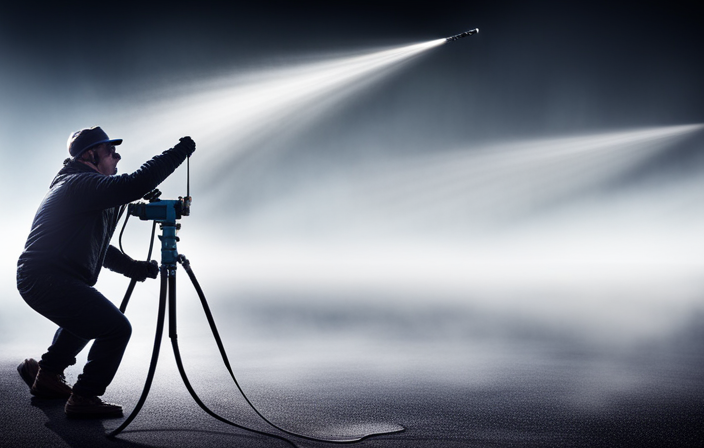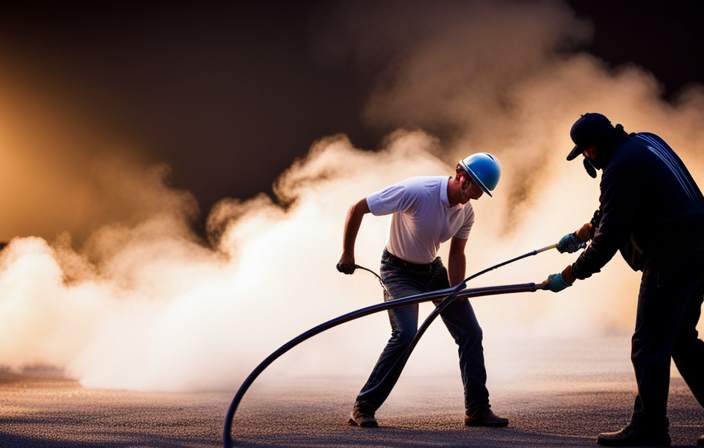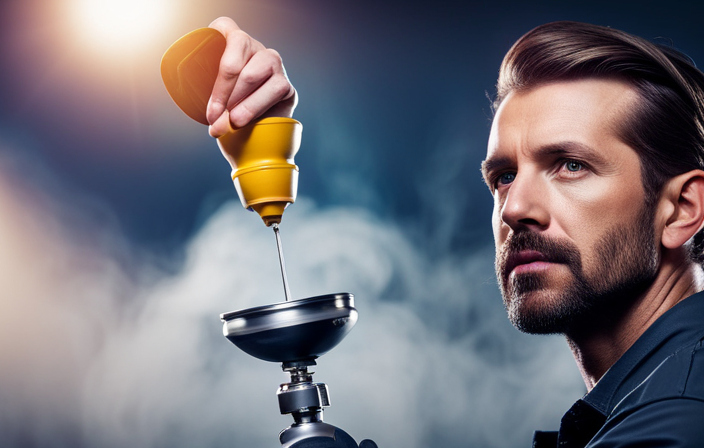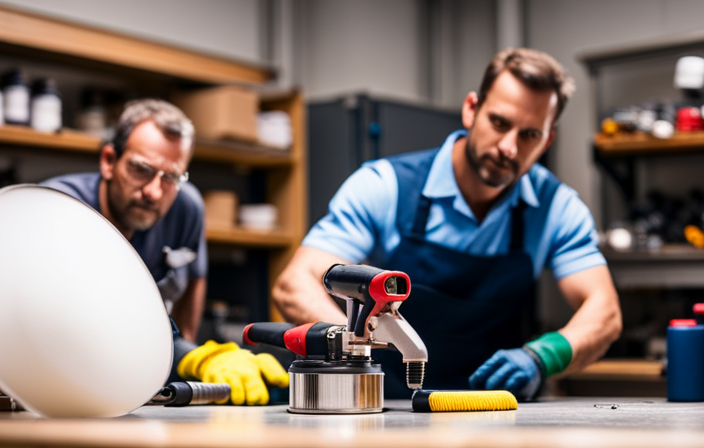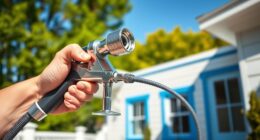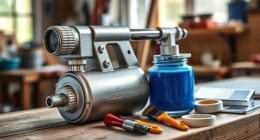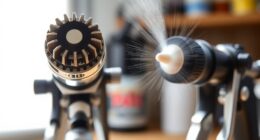In a world full of endless possibilities, the time is now to let your imagination run wild and turn your guitar into a one-of-a-kind masterpiece. While it is commonly said that a picture is worth a thousand words, just think about the power of being able to create a piece of art on your guitar that truly reflects your unique personality and style.
Well, look no further because I’m here to show you how to paint a guitar with an airless paint sprayer.
With this innovative tool in your hands, you’ll be able to achieve professional-looking results without breaking a sweat. From preparing your guitar for painting to choosing the perfect color and applying multiple layers for optimal coverage, I’ll guide you through each step of the process.
And don’t worry if you’re new to painting, because I’ll provide you with all the tips and techniques you need to become a pro in no time.
So, get ready to unleash your inner artist and transform your guitar into a work of art that will leave everyone in awe. Let’s dive into the world of airless paint sprayers and bring your musical masterpiece to life.
Key Takeaways
- Preparing the surface is crucial for a smooth paint job and proper paint adhesion.
- Applying multiple thin and even coats of paint ensures even coverage and a professional finish.
- Proper ventilation is essential for safety and to achieve optimal drying and prevent imperfections.
- Reassembling the guitar requires attention to detail and proper alignment of hardware and electronics.
Prepare Your Guitar for Painting
To prepare your guitar for painting, follow these steps:
-
Rough up the surface: Grab your sandpaper and start roughing up the surface. This is crucial for a smooth and long-lasting paint job. Remove any existing finish or paint using sandpaper or a paint stripper. Remember to sand in the direction of the grain to avoid scratches.
-
Use different grits of sandpaper: Start with a coarse grit and gradually move to a finer grit for a smooth surface. Sanding helps create a better adhesion for the paint.
-
Wipe down the guitar: After sanding, wipe down the guitar with a damp cloth to remove any dust or debris. This ensures a clean surface for painting.
-
Apply primer: Once the surface is clean and smooth, it’s time to prime the guitar. Apply a thin layer of primer to ensure that the paint adheres well and provides a solid base for the color coat.
-
Choose the right paint and color: With the surface prepped and primed, you’re ready to choose the right paint and color for your guitar transformation. Consider factors like the type of paint (acrylic, enamel, etc.) and the color that suits your style.
Remember to take your time and follow each step carefully to achieve the best results.
Choose the Right Paint and Color
When it comes to choosing the right paint for your guitar, there are a few factors to consider.
First, you’ll want to select the type of paint that will adhere well to the guitar’s surface and provide a durable finish.
Additionally, picking the perfect color is an important decision that will reflect your personal style and taste.
With so many options available, it’s essential to take your time and choose a paint color that you’ll be happy with for years to come.
Selecting the Type of Paint
First, you’ll want to choose the perfect type of paint for your guitar to achieve a truly unique and vibrant look. When selecting the type of paint, consider the following:
-
Choosing the right paint finish: The finish you choose will greatly impact the final look of your guitar. Matte finishes offer a subtle and modern appearance, while gloss finishes provide a shiny and polished look. It’s important to choose a finish that aligns with your desired aesthetic.
-
Importance of primer: Before applying the paint, make sure to use a high-quality primer. Primer helps the paint adhere to the surface of the guitar, ensuring a smooth and long-lasting finish. It also helps to seal any imperfections on the guitar’s surface, resulting in a professional-looking paint job.
When picking the perfect color for your guitar, consider your personal style and the overall vibe you want to create. With the right paint and color, you can transform your guitar into a true work of art.
Picking the Perfect Color
To truly make your guitar a showstopper, you’ll want to choose a color that will make jaws drop and eyes widen with envy. When it comes to painting your guitar, the possibilities are endless. Don’t be afraid to think outside the box and choose unique colors that reflect your personality and style. Experimenting with different finishes can also add a touch of uniqueness to your instrument. From glossy to matte, metallic to pearlescent, the choice is yours. To help you visualize the options, here’s a table showcasing some popular colors and finishes that can transform your guitar into a work of art:
| Color | Finish |
|---|---|
| Deep Blue | Metallic |
| Emerald | Glossy |
| Crimson | Matte |
| Gold | Pearlescent |
Now that you’ve chosen the perfect color, it’s time to mask off the areas you don’t want to paint. This will ensure a clean and professional-looking result.
Mask Off the Areas You Don’t Want to Paint
Before grabbing your airless paint sprayer, it’s important to mask off the areas you don’t want to paint. This step ensures a clean and precise canvas for your artistic masterpiece. Start by using painter’s tape to cover the fretboard, hardware, and pickups, or any other parts you want to keep untouched. Press the tape firmly to create a tight seal and prevent paint seepage.
Once you’ve finished painting, carefully remove the tape while the paint is still wet to avoid peeling or damage. With the areas properly masked off, you’re now ready to set up your airless paint sprayer and start transforming your guitar into a work of art.
Set Up Your Airless Paint Sprayer
Once you’ve gathered all your supplies, it’s time to get your airless paint sprayer ready to unleash its artistic power. Setting up the sprayer is crucial for achieving a smooth and even coat of paint on your guitar.
Start by connecting the sprayer to a power source and ensuring that the nozzle is clean and free from any clogs.
Next, adjust the pressure settings according to the type of paint you’re using and the desired coverage.
It’s important to troubleshoot common issues such as leaks or uneven spray patterns before you begin.
Once everything is set up, you can practice your technique and get a feel for the sprayer’s capabilities.
This will help you achieve professional-looking results on your painted guitar.
Practice Your Technique
Before you start painting the guitar with the airless paint sprayer, I highly recommend testing the sprayer on a scrap surface first. This will allow you to familiarize yourself with the sprayer’s settings, adjust the pressure and nozzle size if needed, and ensure that the paint is being evenly distributed.
Additionally, it’s crucial to practice maintaining even strokes while using the sprayer. This will help you achieve a smooth and professional finish on the guitar, avoiding any streaks or uneven coverage. Remember to keep a steady hand and move the sprayer in a consistent motion for the best results.
Test the Sprayer on a Scrap Surface
To truly grab your attention, try this theory and test the sprayer on a scrap surface.
Testing techniques and troubleshooting tips are essential to ensure a smooth and successful painting process.
Start by assembling your airless paint sprayer and connecting it to the air compressor. Adjust the pressure settings according to the manufacturer’s instructions.
Next, fill the sprayer with the desired paint color, making sure it is properly mixed.
Now, aim the sprayer at the scrap surface and pull the trigger to release the paint. Pay attention to the spray pattern and adjust the settings if needed.
Move the sprayer in a steady and even motion, maintaining a consistent distance from the surface.
Practice maintaining even strokes will help you achieve professional-looking results.
Practice Maintaining Even Strokes
Get ready to master the art of smooth and flawless strokes for a jaw-dropping painting finish. To improve spray control and avoid overspray, follow these steps:
-
Hold the airless paint sprayer firmly with both hands, maintaining a steady grip.
-
Start the sprayer in a well-ventilated area away from the guitar, ensuring the nozzle is pointed away from you and any nearby objects.
-
Practice maintaining even strokes by moving the sprayer in a horizontal or vertical motion, keeping a consistent distance from the surface.
By mastering these techniques, you will achieve a professional-looking paint job on your guitar.
Now, it’s time to move on to the next section and start painting your guitar with confidence and precision.
Start Painting Your Guitar
As I begin to paint my guitar, I let my creativity soar like a soaring melody. Before starting, it’s important to prepare the surface by sanding it lightly to create a smooth base.
Next, I apply a clear coat to protect the guitar and enhance the paint’s adhesion. Once the clear coat is dry, I can start painting. Using my airless paint sprayer, I apply thin and even coats of paint, making sure to cover the entire surface. It’s important to maintain a consistent distance from the guitar to ensure an even application.
After the first layer is dry, I can apply additional layers for the desired coverage. This will help the paint adhere better and create a more vibrant finish.
Apply Additional Layers for Desired Coverage
Now that we’ve started painting the guitar, it’s time to apply additional layers for the desired coverage. This step is crucial in achieving a smooth finish and ensuring proper paint adhesion. Here are four key tips to keep in mind while applying multiple coats:
-
Allow each coat to dry completely before applying the next one. This prevents smudging or running.
-
Use light, even strokes to apply the paint. This distributes the paint evenly and avoids streaks or patches.
-
Pay attention to areas that need extra coverage and apply an additional coat if necessary. This ensures even coloring.
-
Keep a close eye on the guitar’s overall appearance as you apply each coat. If you notice imperfections or unevenness, lightly sand the surface before applying the next coat.
By following these tips, you’ll be on your way to achieving a smooth and professional-looking finish. Now, let’s move on to the next section about letting the paint cure.
Let the Paint Cure
After applying the final coat of paint, it’s crucial to let the guitar cure for the recommended drying time. This will ensure that the paint fully adheres to the surface and becomes durable.
During this time, it’s important to keep the guitar in a well-ventilated area to allow proper airflow and aid in the drying process.
Follow the Recommended Drying Time
To achieve optimal results, make sure to follow the recommended drying time for your painted guitar when using an airless paint sprayer. The recommended drying time is crucial as it allows the paint to fully cure and harden, ensuring a durable and long-lasting finish.
Patience is key during this step. Rushing the process can result in a subpar outcome. It’s important to resist the temptation to handle or play your guitar before it has fully dried. Doing so can lead to smudges, fingerprints, or even damage to the paint.
Once the recommended drying time has passed, you can proceed to the next step. Keep the guitar in a well-ventilated area, allowing any residual fumes to dissipate. This ensures a safe and pleasant painting experience.
Keep the Guitar in a Well-Ventilated Area
Make sure you don’t forget to keep your masterpiece in a well-ventilated area, because who doesn’t love inhaling toxic fumes while creating art? Ventilation safety is crucial when painting a guitar with an airless paint sprayer. Here are a few reasons why:
- Proper ventilation ensures that harmful fumes and particles are quickly removed from the air, reducing the risk of respiratory issues.
- It helps prevent the build-up of paint vapors, which can be flammable and pose a fire hazard.
- Adequate airflow allows the paint to dry evenly and prevents the formation of bubbles or streaks.
To ensure proper ventilation safety, make sure to:
- Open windows or use fans to create a steady flow of fresh air.
- Wear a respirator mask to protect yourself from inhaling any potentially harmful substances.
- Keep all other painting equipment, such as brushes and paint cans, in a separate area to avoid contamination.
Now that your guitar is drying in a well-ventilated space, it’s time to move on to the next step of reassembling your instrument.
Reassemble Your Guitar
Now that the paint on my guitar has cured, it’s time for me to reassemble it.
The first step is to clean and reattach the hardware, ensuring that everything is secure and in its proper place.
Next, I will reinstall the pickups and electronics, making sure all the wires are connected correctly and the components are positioned correctly.
It’s important to be meticulous during this process to ensure that the guitar functions properly and looks great.
Clean and Reattach the Hardware
First, gather all of the hardware that you removed from the guitar and give it a thorough cleaning to remove any dirt or grime. Cleaning techniques for the hardware depend on the material it is made of. For metal hardware, use a mild soap and water solution to clean off any dirt or fingerprints. For plastic or acrylic hardware, use a non-abrasive cleaner to avoid scratching the surface. Once cleaned, dry the hardware thoroughly before reattaching it to the guitar.
Below is a table outlining the different cleaning techniques for common guitar hardware:
| Hardware Material | Cleaning Technique |
|---|---|
| Metal | Mild soap and water solution |
| Plastic/Acrylic | Non-abrasive cleaner |
Now that the hardware is clean, it’s time to reattach it to the guitar. This will involve carefully aligning the pieces and securing them in place. Next, we will move on to reinstalling the pickups and electronics.
Reinstall the Pickups and Electronics
To reinstall the pickups and electronics, carefully position them back in place, ensuring correct alignment.
Replace old pickups if they’re not functioning properly or for a different sound.
Troubleshoot any electronic issues before installing.
Connect pickups and electronics according to the wiring diagram specific to your guitar model.
Double-check connections and test electronics for correct functionality.
With pickups and electronics securely installed, move on to finishing touches, like adding a protective clear coat for a professional look.
Finishing Touches
For an extra touch of flair, give your guitar a final coat of clear lacquer to make it shine like a rockstar’s stage presence. This step is crucial in completing the refinishing process and protecting the paint job you’ve worked hard on.
Clear lacquer not only adds a glossy finish, but it also acts as a protective layer against scratches and wear. To apply the lacquer, make sure your guitar is clean and free from dust or debris. Using an airless paint sprayer, apply thin and even coats, allowing each coat to dry before applying the next. Be careful not to apply too much lacquer at once to avoid drips or runs.
Once you’re satisfied with the finish, let the lacquer cure for the recommended time before reassembling the guitar. With this final step, your custom-designed guitar will truly shine like a masterpiece.
Frequently Asked Questions
Can I use any type of paint with an airless paint sprayer?
Can any paint be used with an airless paint sprayer? It’s important to use paints specifically designed for airless sprayers, such as latex or oil-based paints. To achieve a smooth finish, ensure proper thinning and adjust spray pressure accordingly.
How long does the paint need to cure before I can play the guitar again?
To speed up the paint curing process, I recommend using a heat gun or placing the guitar in a warm, dry area. To protect the guitar while the paint is curing, cover it with a cloth or place it in a dust-free environment.
What safety precautions should I take when using an airless paint sprayer?
One interesting statistic to grab your attention: According to a study, around 36% of accidents involving airless paint sprayers are due to lack of proper safety precautions. To ensure your safety, here are some best practices to follow.
Can I use an airless paint sprayer on an electric guitar with electronics?
Yes, you can use an airless paint sprayer on an electric guitar with electronics. However, it is important to take precautions to protect the electronics. I recommend using masking tape and alternative painting methods to avoid damaging the delicate components.
How do I clean and maintain my airless paint sprayer after painting my guitar?
After painting my guitar with an airless paint sprayer, I clean it thoroughly to prevent clogs. I disassemble the sprayer, wash all the parts with warm soapy water, and use a brush to remove any paint residue. Then, I reassemble and store it properly.
Conclusion
In conclusion, painting a guitar with an airless paint sprayer is a rewarding and creative project.
As I put the final touches on my beautifully painted instrument, a sense of accomplishment washes over me.
The smooth and even layers of paint create a mesmerizing visual rhythm, like a symphony of colors.
With each stroke, I brought new life to my guitar, transforming it into a work of art.
So grab your airless paint sprayer and let your creativity flow, turning your guitar into a masterpiece.



